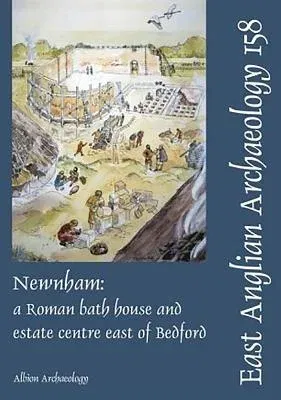Excavations were conducted in the early 1970s at the site of an
elaborate Roman farmstead at Newnham, Bedfordshire. Nearly all of the
Roman remains have been destroyed by gravel quarrying that began in the
1950s. The excavations, under the direction of the late Angela Simco,
recorded part of the core area of the farmstead and recovered
significant assemblages of artifacts and animal bone. Post-excavation
analysis and publication was not completed at the time and the site
archive eventually passed to Bedford Museum in 2000. Funding from the
Aggregates Levy Sustainability Fund, distributed by English Heritage,
allowed the results of fieldwork to be published.
The farmstead probably originated in the 1st century AD, just before the
Roman conquest, and was initially fairly typical of contemporary rural
settlements in the Great Ouse Valley. Settlement was characterized by
ditched enclosures, some of which were used for livestock management,
with a mixture of roundhouses and rectangular buildings of simple
earthfast-post construction. By the end of the 2nd century, however, the
site had acquired at least one relatively substantial rectangular
building with stone foundations, suggesting a degree of 'Romanisation'
not usually apparent on farmsteads in the Bedford region. In the 3rd
century an even more elaborate stone-founded building was constructed,
which comprised a range of rooms with underfloor heating. The stone
footings had been heavily robbed, hampering detailed interpretation, but
three of the hypocaust rooms in the later building are thought to have
been a bath suite.
Elements of the finds assemblage also suggest that the site had a higher
status than that of other farmsteads in the region. Fine-ware pottery
and continental imports are relatively well represented, while ceramic
building materials and painted wall plaster indicate a degree of
prosperity, albeit not on the scale of villa sites known elsewhere. The
faunal assemblage has a species profile somewhere between that of
contemporary local farmsteads and classic villa sites of the wider
region. Other high-status indicators are absent, and the paucity of the
coin assemblage suggests a largely unmonetised economy, at least prior
to the 4th century AD. Because of this apparent ambiguity, the authors
conclude that the Newnham farmstead should not be classed as a 'villa'.
Instead it is suggested that the later buildings housed the
administrative and/or communal functions of a large organized farm,
without the luxurious domestic element of a villa. The focus of farming
operations was probably livestock (mainly cattle and sheep), which
culminated at the end of the 4th century in commercial butchery to
supply lamb or wool to other settlements.
After the end of Roman administration in Britain the ruined farmstead
seems to have been a site of early Anglo-Saxon settlement. This is
evidenced by the presence of Anglo-Saxon pottery, although hardly any
features can be dated to this period.
The main datasets analysed for this report consist of structural
records, pottery (excluding the amphorae, now missing), ceramic building
material, a range of other artifacts (animal products, metalwork, glass,
stone, plaster/mortar and slag), and animal bone. The small collection
of human bone is fragmentary or from unphased contexts and is not
analyzed in detail. Because this is a rather unusual site for the
locality, detailed specialist reports and full catalogues are included
with this report on a CD-ROM, to aid comparison of the Newnham
assemblages with those from other sites.

